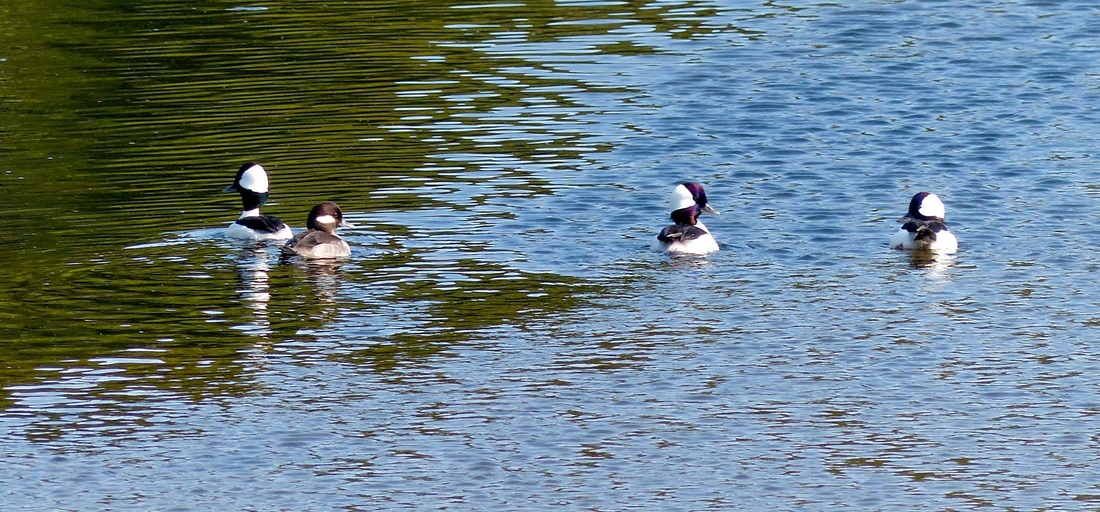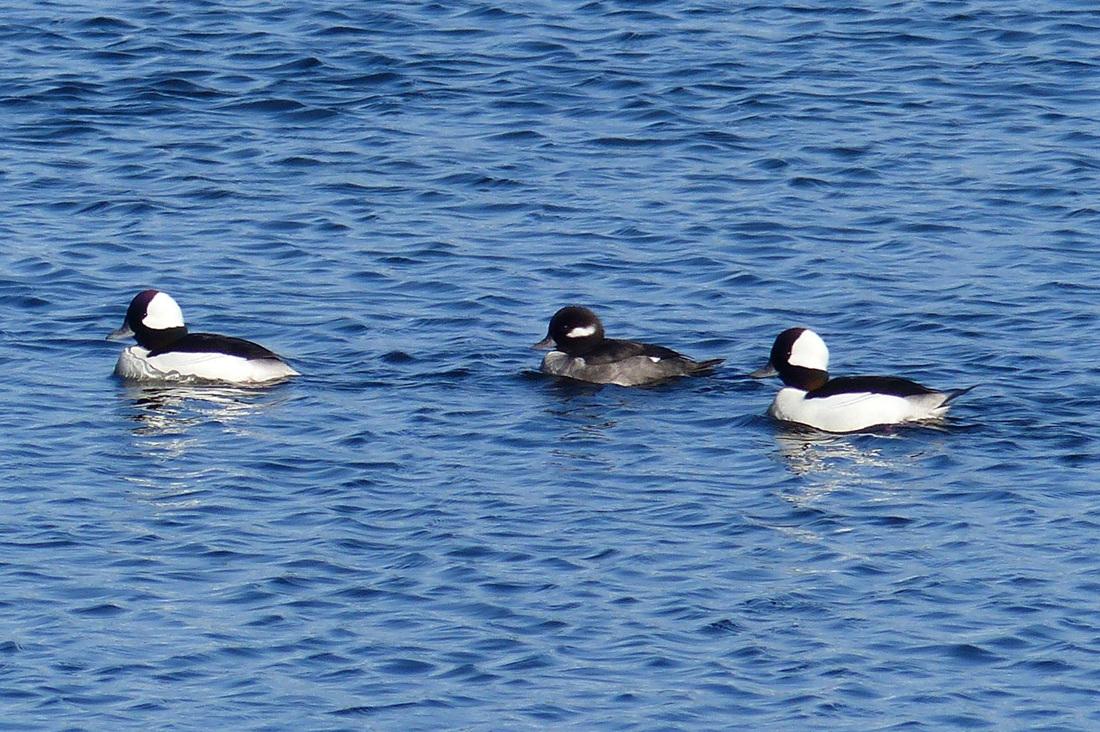Bufflehead • Bucephala albeola
{Bufflehead = from "buffalo-head"}
|
Bottom left: male bufflehead, photographed by Mike Yip.Top and right: males with one female. Photos by Brian Starzomski.
|
Identification
This small duck has a large rounded head and a steep forehead. Its bill is short and wide. The male has a large white patch on the back and sides of its head, contrasting against a glossy iridescent black on the rest of tits head. Its body is black above and white below, with a large white patch on each wing. The female (as well as first-year and eclipse male plumage) is less distinctive, with greyish-brown plumage that is darker on the head and back, and an oval-shaped white patch on each side of the head.
Habitat & Range
The bufflehead can be found in on the Central Coast in winter, when it inhabits saltwater and freshwater areas including sheltered bays, estuaries, lakes, and slow-moving rivers. During the summer breeding season it nests around small lakes and ponds in open forested areas. This bird winters in southern North America, the Great Lakes, and along both coastlines; its summer breeding range extends across much of inland Canada and into Alaska.
Find more information at the British Columbia Breeding Bird Atlas here.
Similar Species
The breeding bufflehead male is quite distinctive, though the female, first year male, and eclipse male are less so. This less distinctive plumage could be confused with the female, first year male, and eclipse male plumage of the common goldeneye (Bucephala clangula) and Barrow's goldeneye (B. islandica), which have brown heads and dull brownish-grey plumage. They lack the white spot at the sides of the head however; the first year males have an indistinct spot between the bill and eye. The dull brownish female harlequin duck (Histrionicus histrionicus) has three white spots on each side of the head.
Intriguing Info
The bufflehead nests in tree cavities, including holes made and abandoned by northern flickers and other woodpeckers.
This small duck has a large rounded head and a steep forehead. Its bill is short and wide. The male has a large white patch on the back and sides of its head, contrasting against a glossy iridescent black on the rest of tits head. Its body is black above and white below, with a large white patch on each wing. The female (as well as first-year and eclipse male plumage) is less distinctive, with greyish-brown plumage that is darker on the head and back, and an oval-shaped white patch on each side of the head.
Habitat & Range
The bufflehead can be found in on the Central Coast in winter, when it inhabits saltwater and freshwater areas including sheltered bays, estuaries, lakes, and slow-moving rivers. During the summer breeding season it nests around small lakes and ponds in open forested areas. This bird winters in southern North America, the Great Lakes, and along both coastlines; its summer breeding range extends across much of inland Canada and into Alaska.
Find more information at the British Columbia Breeding Bird Atlas here.
Similar Species
The breeding bufflehead male is quite distinctive, though the female, first year male, and eclipse male are less so. This less distinctive plumage could be confused with the female, first year male, and eclipse male plumage of the common goldeneye (Bucephala clangula) and Barrow's goldeneye (B. islandica), which have brown heads and dull brownish-grey plumage. They lack the white spot at the sides of the head however; the first year males have an indistinct spot between the bill and eye. The dull brownish female harlequin duck (Histrionicus histrionicus) has three white spots on each side of the head.
Intriguing Info
The bufflehead nests in tree cavities, including holes made and abandoned by northern flickers and other woodpeckers.
References
Bufflehead Bucephala albeola. Audubon Birds. National Audubon Society. Accessed 04/03/2016.
Bufflehead Bucephala albeola. The Birds of North America Online (A. Poole, Ed.). Ithaca: Cornell Lab of Ornithology. Retrieved from the Birds of North America Online. Accessed 04/03/2016.
Dunn, J. L. and Alderfer, J. (Eds.). (1999). National Geographic Field Guide to the Birds of North America. (3rd Ed.). Washington, D.C.: National Geographic Society. Pp. 44-45.
Authors and editors of page
Kelly Fretwell (2016).
Bufflehead Bucephala albeola. Audubon Birds. National Audubon Society. Accessed 04/03/2016.
Bufflehead Bucephala albeola. The Birds of North America Online (A. Poole, Ed.). Ithaca: Cornell Lab of Ornithology. Retrieved from the Birds of North America Online. Accessed 04/03/2016.
Dunn, J. L. and Alderfer, J. (Eds.). (1999). National Geographic Field Guide to the Birds of North America. (3rd Ed.). Washington, D.C.: National Geographic Society. Pp. 44-45.
Authors and editors of page
Kelly Fretwell (2016).






